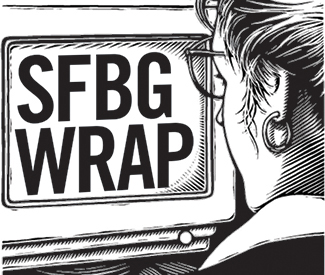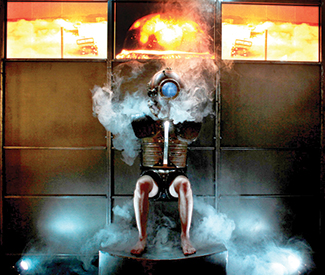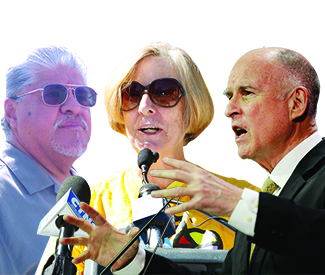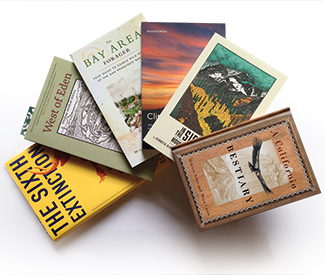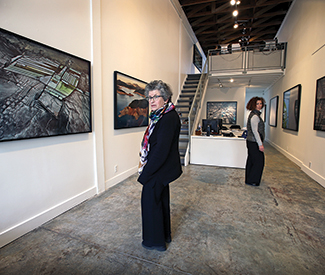Film listings are edited by Cheryl Eddy. Reviewers are Kimberly Chun, Dennis Harvey, Lynn Rapoport, and Sara Maria Vizcarrondo. For rep house showtimes, see Rep Clock.
OPENING
Chef Not to take anything away from the superhero crew, but Chef feels like the closest thing to a labor of love from writer, director, and star Jon Favreau in many a day. As a director, he may have been making doughnuts — fun-filled and teeming with CGI eye candy, but doughnuts nevertheless — when it came to effects-driven blockbusters like 2008’s Iron Man, but this well-meaning play for the heart, by way of the stomach, shows you where Favreau’s head is really at. Chef revolves around Carl Casper (Favreau), a onetime food star, now reduced to serving up predictable crowd-pleasers at the behest of his restaurant’s overbearing owner (Dustin Huffman). It takes the barbs of an influential critic (Oliver Platt) — and an ensuing Twitter war — to set Carl off and send him away on his own, at the coaxing of his glam ex Inez (Sofia Vergara). Hooked up with a dilapidated food truck and former kitchen staffer Martin (John Leguizamo), and aided by ably Tweeting son Percy (Emjay Anthony), Carl ties his dreams — and lost passion — to the classic Cuban sandwich. The ensuing road trip from Miami to LA, and Carl’s journey toward self and a renewed relationship with his son, is a fun (if, in the end, a bit too speedily sketched) vault through the joys of eating your way through America’s new culinary heartland. Amid the volley of sign-of-the-times social-media swinging and cameos by the uncostumed Robert Downey Jr., Scarlett Johansson, and the like, Favreau’s main dish is that a family that eats, cooks, and runs a business together, stays together — child labor laws or no. (1:55) (Chun)
Documented See “Home Brew.” (1:29) Roxie.
The Double Simon (Jesse Eisenberg) is a lowly clerk who gets nothing but indifference and scorn both at work and in his pitiful private life. Things slip even more insidiously beyond his control with the arrival of James (Eisenberg again), his exact doppelgänger — though no one else seems to notice that — and a climber as ruthlessly efficient as Simon is hapless. Not only does he steal his look-alike’s ideas in a rapid rise to the top, he seems to take great pleasure in kicking Simon further downward. Applying a Kafkaesque gloss to Dostoyevsky’s novella, with stylistic hat-tips to the Coens and Terry Gilliam, Richard Ayoade’s second feature is very different from his prior Submarine (2010) in all ways but one: It, too, is both overwhelmed and rendered fascinating by an excess of high directorial “style” whose self-consciousness infuses every frame and puts quote marks around every emotion. As a result, The Double is a striking objet d’art you’ll either love or hate — or enjoy aesthetically while being annoyed by its sacrifice of depth for a showoff surface. (1:33) Opera Plaza, Shattuck. (Harvey)
God’s Pocket The dreary directorial debut of Mad Men star (and occasional episode director) John Slattery begins with a funeral, and it’s not long before we realize the deceased, Leon (Caleb Landry Jones), will be grieved only by his mother (Christina Hendricks). Most of this bleak tale takes place in flashback — racist, jacked-up Leon’s workplace accident (actually a well-deserved blow to the head, wielded by a fellow laborer he’d been threatening) occurs while his boozy-schlub stepfather Mickey (Philip Seymour Hoffman, in one of his final roles) is boosting a refrigerated truck for use in his meat business. When his wife demands an investigation into Leon’s death, Mickey dutifully, if reluctantly, asks some of his ne’er-do-well associates to poke around; one thing leads to another, more blood is shed, and the stolen truck is repurposed for toting around a certain albatross of a human corpse. Set in 1978 and named for the fictional working-class Philly neighborhood that provides its backdrop, God’s Pocket (based on the novel by Pete Dexter, whose other adapted works include The Paperboy and Paris Trout) falls quite short of delivering narrative satisfaction; even its stellar cast (which also includes John Turturro, Eddie Marsan, and Richard Jenkins — the latter as a washed-up journalist who improbably seduces Hendricks’ character) can’t elevate characters that are thinly drawn and murkily motivated. (1:28) Embarcadero, Shattuck. (Eddy)
Godzilla He’s baaaaack. (2:03) Four Star, Marina.
Million Dollar Arm Jon Hamm has it bad — that dark-around-the-edges Mad Men afterglow can’t help but follow him everywhere, even into the arms of Disney in this solid Cinderella-story baseball tale (possibly the best headlining gig he’s had outside SCDP). Hamm’s J.B. Bernstein would certainly have something to hash over with Don Draper: both are down-on-their-luck charmers with the cracks in their facades clearly showing, yet nonetheless intent on doing it their way. J.B. is striking out when it comes to recruiting talent for his new, rapidly sinking sports agency, when he comes up with a genius idea while he and fellow agent Aash (Aasif Mandvi) are watching random sports at the latter’s home: Why not tap into one of the world’s greatest unexploited baseball markets by staging a talent search for an Indian cricket player with Major League pitching potential? Canvassing the country with the help of sleepy scout Ray (Alan Arkin) and baseball-enthusiast translator Amit (Pitobash), J.B. finds his arms ultimately attached to village truck driver Dinesh (Madhur Mittal) and contorting track-and-field thrower Rinku (Suraj Sharma of 2012’s Life of Pi). But how to turn raw talent into professional careers in just months? And moreover, how can the would-be golden boys overcome cultural barriers that a fly ball couldn’t surmount? It’s a tryout for all concerned — including an MLB that’s still striving to expand its reach in Asia, and Hamm, who can be so good as Draper that he’s in increasing danger of being typecast. In the Disney mold, at least, his character achieves fairly happy results. (2:00) Presidio, Shattuck, Vogue. (Chun)
Palo Alto Adapted from the 2010 short story collection by James Franco, first-time director Gia Coppola’s depressive, aimless tale of disaffected youth tracks the ennuis and misadventures of a handful of Palo Alto teenagers: shy, inexperienced April (Emma Roberts), teetering on the edge of an affair with her soccer coach (Franco); naively promiscuous Emily (Zoe Levin); budding head case Fred (Nat Wolff); and his friend Teddy (Jack Kilmer, son of Val, who plays April’s out-to-lunch stepfather), who ambivalently participates in Fred’s mayhem while pining after April. Adult supervision is nearly Peanuts-level sparse — in other Peninsula households, helicopter parents may be fine-tuning the lives of their children down to the last extracurricular; here, the stoned, distracted elders who occasionally wander in front of the camera are more like flaky, absentee roommates. Meanwhile, their young charges fill the empty hours with copious amounts of alcohol consumption, random property destruction, and a round or two of social crucifixion. The protagonists and their cohorts form a fairly distasteful tableau of privileged, floundering adolescence, eliciting an emotional response in which uneasy concern occasionally overcomes bemused disgust. But the individual stories are virtually weightless, and the characters’ lack of investment in anything, even their own problems, makes it difficult to care too much about their fates. (1:38) California, Embarcadero, Smith Rafael. (Rapoport)
Tasting Menu No restaurant was more lauded in its lifespan than Ferran Adrià’s legendary El Bulli, which closed in 2011. Naturally, someone made a documentary about the joint — which was located on Spain’s Costa Brava — and now there’s Tasting Menu, an ensemble Euro-comedy that takes place at “Chakula,” a 30-seat restaurant on Spain’s Costa Brava. Why is the apparently successful Chakula closing? Gorgeous chef Mar (Vicenta N’Dongo) isn’t saying, nor is she revealing the final menu — and neither is director and co-writer Roger Gual (2002’s Smoking Room). We catch glimpses of artfully plated dishes as they’re assembled in the kitchen and whisked around the seaside dining room (and get one descriptor: “Snail caviar”), but this ain’t Like Water for Chocolate-level cooking porn. Gual is mostly concerned with the diners themselves, all of whom are rich, well-connected, or lucky enough to have scored the most exclusive reservation on the planet. Alas, there’s not a truly compelling personality among them, though a salty widow (Fionnula Flanagan) who dines with an urn containing her husband’s ashes, and a mysteriously morose man (Stephen Rea) who may or may not be a food critic, come the closest. Elsewhere, there’s estranged couple Rachel and Marc (Claudia Bassols and Jan Cornet); a nervous maître d’ (Andrew Tarbet) charged with overseeing the top-secret surprise dessert; a pair of grouchy Japanese businessmen who are competing to take over the restaurant after Mar steps aside; and assorted other stereotypes and rivals tossed in to bring tension to what’s essentially a pleasant-yet-woefully-unexciting dinner party. (1:25) Opera Plaza. (Eddy)
ONGOING
The Amazing Spider-Man 2 The best thing about The Amazing Spider-Man 2 — the sequel to the 2012 reboot that nobody really wanted in the first place — is the achingly cute chemistry between real-life couple Andrew Garfield (Peter Parker/Spider-Man) and Emma Stone (Gwen Stacy, whose fate is no spoiler to anyone who is familiar with the Spider-Man canon). Can’t deny it; those two are adorbs. But since Spider-Man is supposed to be an action movie, not a romantic comedy, it spends most of its time setting up foes for the webslinger (Jamie Foxx as a nerd zapped into the power-mad Electro; Dane DeHaan as bratty rich kid Harry Osborn), as well as rehashing the mysterious deaths of Peter’s parents, and underlining for approximately the zillionth time the disconnect between the media’s perception of Spider-Man (he’s a menace! He interferes with police work!) and the ecstatic love the people of New York have for the guy — understandable, since he’s in the business of saving their butts on a regular basis. This isn’t a crappy movie by any means; it’s entertaining enough, and the 3D swooping-between-skyscrapers FX have gotten quite dazzling. But there’s still a heavy air of “This again?” that hangs over the whole thing. Doesn’t Marvel have enough dough from the Avengers movies to let Spidey take an extended vacation? (2:20) Balboa, Marina (showing the original version and a version with Chinese subtitles), Metreon, 1000 Van Ness, Sundance Kabuki. (Eddy)
Belle The child of a British naval officer and a Caribbean slave, Belle (Gugu Mbatha-Raw) is deposited on the doorstep — well, the estate grounds — of her father’s relatives in 1769 England after her mother dies. Soon she’s entirely orphaned, which makes her a wealthy heiress and aristocratic title holder at the same time that she is something less than human in the eyes of her adopted society. For Belle is black (or more properly, mixed-race), and thus a useless curiosity at best as a well-bred noblewoman of the “wrong” racial makeup. Based on a murky actual historical chapter, Amma Asante’s film is that rare sumptuous costume drama which actually has something on its mind beyond romance and royalty. Not least among its pleasures are a fine supporting cast including Tom Wilkinson, Miranda Richardson, Penelope Wilton, and Emily Watson. (1:45) Albany, Embarcadero, Piedmont, Sundance Kabuki. (Harvey)
Brick Mansions (1:30) Metreon, 1000 Van Ness.
Captain America: The Winter Soldier Marvel’s most wholesome hero returns in this latest film in the Avengers series, and while it doesn’t deviate from the expected formula (it’s not a spoiler to say that yes, the world is saved yet again), it manages to incorporate a surprisingly timely plot about the dangers of government surveillance. Steve Rogers (Chris Evans), hunkiest 95-year-old ever, is still figuring out his place in the 21st century after his post-World War II deep freeze. Nick Fury (Samuel L. Jackson) has him running random rescue missions with the help of Black Widow (Scarlett Johansson), but SHIELD is working on a top-secret project that will allow it to predict crimes before they occur. It isn’t long before Cap’s distrust of the weapon — he may be old-fashioned, but he ain’t stupid — uncovers a sinister plot led by a familiar enemy, with Steve’s former BFF Bucky doing its bidding as the science-experiment-turned-assassin Winter Soldier (Sebastian Stan). Anthony Mackie, Robert Redford, and series regular Cobie Smulders are fine in supporting roles, and Johansson finally gets more to do than punch and pose, but the likable Evans ably carries the movie — he may not have the charisma of Robert Downey Jr., but he brings wit and depth to a role that would otherwise be defined mainly by biceps and CG-heavy fights. Oh, and you know the drill by now: superfans will want to stick around for two additional scenes tucked into the end credits. (2:16) Metreon, 1000 Van Ness, Sundance Kabuki. (Eddy)
Divergent Based on the blockbuster dystopian-future YA novel by Veronica Roth (the first in a trilogy), Divergent is set in a future city-state version of Chicago in which society is divided into five character-based, color-coded factions: Erudite, Amity, Candor, Abnegation, and Dauntless. Like her peers, Beatrice Prior (Shailene Woodley), the film’s Abnegation-born teenage heroine, must choose a permanent faction — with the help of a standardized aptitude test that forgoes penciling in bubbles in favor of virtual reality psychic manipulation. When the test fails to triangulate her sole innate personality trait, she learns that she belongs to a secret, endangered sixth category: Divergent, an astonishing set of people who are not only capable of, say, acts of selflessness but can also produce intelligent thought, or manifest bravery in the face of danger. Forced to hide her aberrant nature in a society whose leaders (Kate Winslet) are prone to statements like “The future belongs to those who know where they belong,” and seemingly bored among Abnegation’s hive of gray cardigan-wearing worker bees, Beatrice chooses Dauntless, a dashing gang of black-clad, alterna-rock music video extras who jump on and off moving trains and live in a warehouse-chic compound whose dining hall recalls the patio at Zeitgeist. Fittingly, a surly, tattooed young man named Four (Theo James) leads Beatrice, now Tris, and her fellow initiates through a harsh proving regimen that, if they fail, will cast them into an impoverished underclass. Director Neil Burger (2006’s The Illusionist, 2011’s Limitless) and the behemoth marketing force behind Divergent are clearly hoping to stir up the kind of madness stoked by the Twilight and Hunger Games series, but while there are bones a-plenty to pick with those franchises, Divergent may have them beat for pure daffiness of premise and diameter of plot holes — and that’s after screenwriters Evan Daugherty and Vanessa Taylor’s major suturing of the source material’s lacunae. The daffiness doesn’t translate into imaginative world-building, and while a couple of scenes convey the visceral thrills of life in Dauntless, the tension between Tris and Four is awkwardly ratcheted up, and the film’s shift into a mode of crisis is equally jolting without generating much heat. (2:20) Metreon, 1000 Van Ness. (Rapoport)
Draft Day (2:00) SF Center.
Fading Gigolo Ah, the charm of a well-aged, seasoned perv &ldots; nope, we don’t dare touch the Woody Allen/Dylan Farrow abuse allegations — though those recent headlines flit around the edges of this generally benevolent, almost strangely innocuous charmer, written by and directed John Turturro, who also stars as the curiously blank-faced tabula rasa of a title character. The delights of Mrs. Robinsons have been rhapsodized on film, through the lens of worshipful younger men — less so, their male counterparts, as viewed by other hetero men. The danger of bromance surging into the homoerotic is likely too dire for most, yet somehow bookstore boss Murray (Allen) sees the mysterious, submerged sex appeal in his loyal employee Fioravante (Turturro) and taps him to get involved in a ménage à trois with a society dermatologist (Sharon Stone). The soft-spoken Fioravante turns out to be a smash in the sack with the doc, transforming the opportunistic Murray into a wildly successful pimp as his employee takes on the audacious Selima (Sofia Vergara) and the prim Jewish Orthodox widow Avigal (Vanessa Paradis). The latter character seems to have come straight from another place and time — much like this film, which turns Brooklyn into a something resembling a leaf-strewn European village and recalls odes to revolutionary sexuality in the ’60s. The movie’s lightly absurd comedy is embedded in the fact that Turturro writes himself into the role of the seducer, the pleaser, while wrapped in the skin of pleasant if everyday-looking Joe, although Paradis, a revelation as a deeply repressed devout mother slowly awakening to her body, points to more serious pleasures, lingering below the surface of all of us. (1:30) Albany, Embarcadero, 1000 Van Ness, Piedmont, Sundance Kabuki. (Chun)
Finding Vivian Maier Much like In the Realms of the Unreal, the 2004 doc about Henry Darger, Finding Vivian Maier explores the lonely life of a gifted artist whose talents were discovered posthumously. In this case, however, the filmmaker — John Maloof, who co-directs with Charlie Siskel — is responsible for Maier’s rise to fame. A practiced flea-market hunter, he picked up a carton of negatives at a 2007 auction; they turned out to be striking examples of early street photography. He was so taken with the work (snapped by a woman so obscure she was un-Google-able) that he began posting images online. Unexpectedly, they became a viral sensation, and Maloof became determined to learn more about the camerawoman. Turns out Vivian Maier was a career nanny in the Chicago area, with plenty of former employers to share their memories. She was an intensely private person who some remembered as delightfully adventurous and others remembered as eccentric, mentally unstable, or even cruel; she was a hoarder who was distrustful of men, and she spoke with a maybe-fake French accent. And she was obsessed with taking photographs that she never showed to anyone; the hundreds of thousands now in Maloof’s collection (along with 8mm and 16mm films) offer the only insight into her creative mind. “She had a great eye, a sense of humor, and a sense of tragedy,” remarks acclaimed photographer Mary Ellen Mark. “But there’s a piece of the puzzle missing.” The film’s central question — why was Maier so secretive about her hobby? — may never be answered. But as the film also suggests, that mystery adds another layer of fascination to her keenly observed photos. (1:23) Opera Plaza, Shattuck. (Eddy)
The Galapagos Affair: Satan Came to Eden Extensive archival footage and home movies (plus one short, narrative film) enhance this absorbing doc from San Francisco-based Dayna Goldfine and Dan Geller (2005’s Ballets Russes). It tells the tale of a double murder that occurred in the early 1930s on Floreana — the most remote of the already scarcely-populated Galapagos Islands. A top-notch cast (Cate Blanchett, Diane Kruger, Connie Nielsen, Josh Radnour) gives voice to the letters and diary entries of the players in this stranger-than-fiction story, which involved an array of Europeans who’d moved away from civilization in search of utopian simplicity — most intriguingly, a maybe-fake Baroness and her two young lovers — and realized too late that paradise isn’t all it’s cracked up to be. Goldfine and Geller add further detail to the historic drama by visiting the present-day Galapagos, speaking with residents about the lingering mystery and offering a glimpse of what life on the isolated islands is like today. (2:00) Opera Plaza, Shattuck. (Eddy)
The German Doctor Argentine writer-director Lucía Puenzo (2007’s XXY) adapts her novel Wakolda for this drama imagining a post-World War II chapter in the life of Nazi doctor Josef Mengele. It’s 1960, and there’s a new doctor residing in Bariloche, Argentina — a stunningly picturesque town in the Andean foothills that seems to harbor an awful lot of Germans. Polite, well-dressed “Helmut” (Alex Brendemühl) befriends innkeepers Eva (Natalia Oreiro) and Enzo (Diego Peretti), taking a special interest in their 12-year-old daughter Lilith (Florencia Bado), whose petite frame (cruel classmates call her “dwarf”) awakens his let’s-experiment impulses. He gets even more attached when he finds out a pregnant Eva is carrying twins. Meanwhile, Israeli agents are moving in, having just snagged Mengele’s fellow war criminal Eichmann in Buenos Aires, and Lilith’s family soon catches on to their new friend’s true identity. Measured, multi-lingual performances — Brendemühl is both suave and menacing as the “Angel of Death,” forever penciling in his grotesque medical sketchbook — and the contrast between The German Doctor‘s dark themes and the Patagonian beauty of its setting bring haunting nuance to Puenzo’s twisted-history tale. (1:33) Embarcadero, Shattuck. (Eddy)
The Grand Budapest Hotel Is this the first Wes Anderson movie to feature a shootout? It’s definitely the first Anderson flick to include a severed head. That’s not to say The Grand Budapest Hotel, “inspired by” the works of Austrian novelist Stefan Zweig, represents too much of a shift for the director — his intricate approach to art direction is still very much in place, as are the deadpan line deliveries and a cast stuffed with Anderson regulars. But there’s a slightly more serious vibe here, a welcome change from 2012’s tooth-achingly twee Moonrise Kingdom. Thank Ralph Fiennes’ performance as liberally perfumed concierge extraordinaire M. Gustave, which mixes a shot of melancholy into the whimsy, and newcomer Tony Revolori as Zero, his loyal lobby boy, who provides gravitas despite only being a teenager. (Being played by F. Murray Abraham as an older adult probably helps in that department.) Hotel‘s early 20th century Europe setting proves an ideal canvas for Anderson’s love of detail — the titular creation rivals Stanley Kubrick’s rendering of the Overlook Hotel — and his supporting cast, as always, looks to be enjoying the hell out of being a part of Anderson’s universe, with Willem Dafoe, Jeff Goldblum, and Adrien Brody having particularly oversized fun. Is this the best Wes Anderson movie since 2001’s The Royal Tenenbaums? Yes. (1:40) California, Presidio, SF Center, Shattuck, Sundance Kabuki. (Eddy)
Heaven is for Real (1:40) Metreon.
Ilo Ilo Set in 1997 Singapore at the onset of the country’s recession, Ilo Ilo focuses on one family, who could be any family: father Teck (Chen Tianwen), who’s been let go from his sales position and is working various hourly jobs, hoping his wife doesn’t find out; pregnant Hwee Leng (a dynamic Yeo Yann Yann), a secretary who’s been the “bad cop” in the relationship so long she’s kind of grown into the role; and bratty Jiale (Koh Jia Ler), a 10-year-old terror who disobeys at home and gets into fights at school. Into this swirl of domestic tension comes Teresa (Angeli Bayani), a housekeeper-nanny who’s left her own family behind in the Philippines in search of a better way of life. It’s hell at first — “Auntie Terry” is no Mary Poppins, but she has the patience of a saint, putting up with Jiale’s antics and Hwee Leng’s ice-queen routine. Slowly, however, she builds a rapport with her young charge, but since Ilo Ilo is firmly interested in realism, there’s no quick fix to the problems that lie beneath the family strife, despite the kid’s obsession with lottery numbers. A remarkably assured debut film from 29-year-old director Anthony Chen, Ilo Ilo picked up the Camera D’Or at Cannes, in addition to multiple other fest prizes. The accolades are well-earned — rarely has a film so effectively and subtly captured the day-to-day frustrations of middle-class financial uncertainty. (1:40) Four Star. (Eddy)
Legends of Oz: Dorothy’s Return (1:28) Metreon, 1000 Van Ness, Presidio.
Locke This virtual solo show stars Tom Hardy as Ivan Locke, a 40-ish construction manager driving to London on the eve of “the biggest cement pour” ever attempted in Europe. But he’s driving away from that, to the shrill indignation of superiors who expect his reliable on-site supervision, and the increasingly drunken panic of the flunky (voice of Andrew Scott) he’s deputized to take his place. The reason for this unprecedented dereliction of responsibility is that Ivan is committed to another responsibility, to “take care of my fuckup.” As we gradually realize during his 85-minute drive, that means showing up for the premature birth of the baby he’s sired by a fragile, rather hysterical-sounding woman (Olivia Colman) in the brief sole detour from marital infidelity he’s ever taken. Doing so may well end his career, as well as his long-standing marriage to the mother of his sons. But our protagonist is determined at any cost not to become his own late father (with whom he has imaginary conversations), a wastrel who never made good on his obligations to family or anyone else. Shot repeatedly in real time with multiple cameras over 12 nights, then assembled from 16 full-length takes, Steven Knight’s Locke is a striking experiment that never quite escapes an air of theatrical stunt. In retrospect you realize most of its tension derives not from the core emotional crises, but from narrative red herrings — primarily our terror that anyone multitasking this recklessly behind the wheel is an accident waiting to happen. But the chameleonic Hardy, playing a rather square, middle-class, essentially humorless type unlike any he’s done before, makes this effortfully “decent” man so compelling you can’t look away. If there’s anything this actor can’t do, he hasn’t tried it yet. (1:35) California, Clay, Metreon. (Harvey)
The Lunchbox Ila (Nimrat Kaur) is a self-possessed housewife and a great cook, whose husband confuses her for another piece of furniture. She tries to arouse his affections with elaborate lunches she makes and sends through the city’s lunchbox delivery service. Like marriage in India, lunchbox delivery has a failure rate of zero, which is what makes aberrations seem like magical occurrences. So when widow Saajan (Irrfan Khan) receives her adoring food, he humbly receives the magical lunches like a revival of the senses. Once Ila realizes her lunchbox is feeding the wrong man she writes a note and Saajan replies — tersely, like a man who hasn’t held a conversation in a decade — and the impossible circumstances lend their exchanges a romance that challenges her emotional fidelity and his retreat from society. She confides her husband is cheating. He confides his sympathy for men of lower castes. It’s a May/December affair if it’s an affair at all — but the chemistry we expect the actors to have in the same room is what fuels our urge to see it; that’s a rare and haunting dynamic. Newcomer Kaur is perfect as Ila, a beauty unmarked by her rigorous distaff; her soft features and exhausted expression lend a richness to the troubles she can’t share with her similarly stoic mother (Lillete Dubey). Everyone is sacrificing something and poverty seeps into every crack, every life, without exception — their inner lives are their richness. (1:44) Balboa, Opera Plaza, Shattuck. (Vizcarrondo)
Neighbors It’s a mystery why Neighbor‘s marketing teams are intent on creating some kind of social media battle between this comedy’s family and frat: The college boys are clearly outclassed when it comes to uninhibited physical comedy daring, thanks to Seth Rogen and Rose Byrne. They play young parents Kelly and Mac, who are still basking in their new craftsman home and settled state, trying to figure out sex in front — or is it behind? — baby, and how to get to the rave before bedtime, when a frat, led by oft-shirtless hottie Teddy (Zac Efron) and pal Pete (Dave Franco), moves into the house next door. How do you ask them to “keep it down” yet still be cool? The pretzels Mac and Kelly wrap themselves into, in order to still hang with the kids, are about as hilarious as the inevitable battles that break out over the hearts and minds of college administrators (Lisa Kudrow), pals (the hilarious Ike Barinholtz), and wannabe brothers like the loyal Assjuice (Craig Roberts). Still, despite some memorable gags, Neighbors feels like a bit of a squandered opportunity as one fidgets through many of the frat house scenes. Part of the problem is, why would Kelly, Mac, or anyone want to be in good with such an uninteresting group of Greeks? (1:37) Four Star, Metreon, 1000 Van Ness, Presidio, Shattuck, Sundance Kabuki. (Chun)
Noah Darren Aronofsky’s Biblical epic begins with a brief recap of prior Genesis events — creation is detailed a bit more in clever fashion later on — leading up to mankind’s messing up such that God wants to wipe the slate clean and start over. That means getting Noah (Russell Crowe), wife Naameh (Jennifer Connelly), and their three sons and one adopted daughter (Emma Watson) to build an ark that can save them and two of every animal species from the imminent slate-wiping Great Flood. (The rest of humanity, having sinned too much, can just feed the fishes.) They get some help from fallen angels turned into Ray Harryhausen-type giant rock creatures voiced by Nick Nolte and others. There’s an admirable brute force and some startling imagery to this uneven, somber, Iceland-shot tale “inspired” by the Good Book (which, needless to say, has endured more than its share of revisions over the centuries). Purists may quibble over some choices, including the device of turning minor Biblical figure Tubal-Cain (Ray Winstone) into a royal-stowaway villain, and political conservatives have already squawked a bit over Aronofsky’s not-so-subtle message of eco-consciousness, with Noah being bade to “replenish the Earth” that man has hitherto rendered barren. But for the most part this is a respectable, forceful interpretation that should stir useful discussion amongst believers and non believers alike. Its biggest problem is that after the impressively harrowing flood itself, we’re trapped on the ark dealing with the lesser crises of a pregnancy, a discontented middle son (Logan Lerman), and that stowaway’s plotting — ponderous intrigues that might have been leavened if the director had allowed us to hang out with the animals a little, rather than sedating the whole menagerie for the entire voyage. (2:07) 1000 Van Ness, SF Center. (Harvey)
Now: In the Wings on a World Stage In 2011, a production of Richard III starring Kevin Spacey played SF’s Curran Theatre; it was but one stop on a dreamy world tour (London, Istanbul, Beijing, Sydney, Doha, Brooklyn, and Epidaurus, Greece) for an American and British company and crew directed by Brit Sam Mendes, who guided Spacey to an Oscar (and earned one himself) for 1999’s American Beauty. This backstage doc — fully endorsed by Spacey and co., so don’t expect any juicy spats or diva routines — follows this rambling troupe around the world as they work through one of Shakespeare’s most iconic history plays. Initially, some of the younger actors feel intimidated (and some of the Americans feel nervous about interpreting the Bard alongside Brits, despite the fact that superstar Spacey is spearheading the whole thing), but gradually the group becomes close-knit. Pretty scenery aside, most of the travel stuff is featherweight (“The culture [in Istanbul] is just crazy!” is one typically shallow insight), but watching the show from the inside out offers an intriguing look at the dramatic process. Still, as Mendes and others point out, “the thrill of theater is the fact that it’s live” and “ephemeral” — qualities not captured by this rather conventional doc. If you’re an aspiring actor, however, Now is probably essential viewing nonetheless. (1:33) Roxie. (Eddy)
Only Lovers Left Alive Jim Jarmusch has subverted genre films before — you don’t have to dig deep to find fierce defenders of 1995 Western Dead Man — but his latest, Only Lovers Left Alive, is poised to be his biggest commercial hit to date. That’s not merely because it’s a vampire film, though this concession to trendiness will certainly work in its favor, as will the casting of high-profile Avengers (2012) star Tom Hiddleston. But this is still a Jarmusch vampire movie, and though it may be more accessible than some of the director’s more existential entries, it’s still wonderfully weird, witty, and — natch — drenched in cool. The opening credits deploy a gothic, blood red font across a night sky — a winking nod to the aesthetics of Hammer classics like Horror of Dracula (1958). Then, the camera begins to rotate, filming a record as it plays, and symbolizing the eternal life of the two figures who’ve entered the frame: gloomy Adam (Hiddleston, rocking a bedhead version of Loki’s dark ‘do), who lurks in a crumbling Detroit mansion, and exuberant Eve (Tilda Swinton, so pale she seems to glow), who dwells amid piles of books in Tangier. These two live apart, partially due to the hassle of traveling when one can’t be in the sun (red-eye flights are a must). Yet they remain entangled in spirit, a phenomenon referenced amid much talk of what Einstein called “spooky action at a distance,” and when at last they reunite, it’s glorious. Unlike those old Hammer films, there’s no stake-wielding Van Helsing type pursuing these creatures of the night; if there’s a villain, it’s actual and emotional vampire Ava (Mia Wasikowska), Eve’s bad-penny sibling, who swoops in for a most unwelcome visit. But Only Lovers Left Alive‘s biggest antagonist is simply the outside world, with its epidemics of dull minds and blood-borne diseases. The delight Jarmusch takes in tweaking the vampire mythos is just as enjoyable as his interest in exploring the agony, ecstasy, and uneventful lulls of immortality. (2:03) Embarcadero, Shattuck, Sundance Kabuki. (Eddy)
The Other Woman Cameron Diaz gets top billing — and the title role — in The Other Woman, but Leslie Mann is the real stealth weapon here: the other comedian who bravely dares to go into unseemly crazy-bitch, scatological-Bridesmaids territory, with shrill histrionics, whining, and shrieks hitting registers that threaten to make most men’s heads explode. Coming on like Lucille Ball on crystal, Mann teeters out in the limb in kitten heels — and your enjoyment of The Other Woman depends on whether you love that balancing act or loathe it. Diaz and Mann’s reluctant-then-mutual girl crush is at the heart of this proudly chick flick directed by Nick Cassavetes, who tends to beat his own indie path apart from his involvement in one of the biggest lady draws of all time, The Notebook (2004). The chick magnet and cause for so much chaos is Mark (Nikolaj Coster-Waldau), a sketchy entrepreneur who skims wife Kate’s (Mann) business ideas and toys with power-bitch lawyer Carly (Diaz), as well as his other other woman, perfect-10 Amber (Kate Upton). Coster-Waldau throws himself into the hysteria, as if it were the sole lifeline out of dour King’s Landing, but this is the Mann and Diaz Show, with a smarter-than-average screenplay by Melissa Stack and revenge served up like a self-righteous side dish at a Real Housewives buffet line. And just to show you how far we haven’t come, like those benighted housewives, those assembled aren’t so feminist that they won’t stoop to deliver a bitchy joke at the expense of Upton’s character. (1:49) 1000 Van Ness, Presidio, SF Center. (Chun)
The Quiet Ones (1:38) Metreon.
The Railway Man The lackluster title — OK, it’s better than that of director Jonathan Teplitzky’s last movie, 2011’s Burning Man, which confused sad Burners everywhere — masks a sensitive and artful adaptation of Eric Lomax’s book, based on a true story, about an English survivor of WWII atrocities. As Railway Man unfolds, we find Eric (Colin Firth), a stammering, attractive eccentric, oddly obsessed with railway schedules, as he meets his sweet soul mate Patti (Nicole Kidman) in vaguely mid-century England. Their romance, however, takes a steep, downward spiral when Patti discovers her new husband’s quirks overlay a deeply damaged spirit, one with scars that never really healed. As Eric grows more isolated, his best friend Finlay (Stellan Skarsgard) reveals some of their experiences as POWs forced to toil on the seemingly impossible-to-build Thai-Burma Railway by Japanese forces. The brutality of the situation comes home when the young Eric (played by Jeremy Irvine of 2011’s War Horse) takes the rap for building a radio and undergoes a period of torture. The horror seems rectifiable when Finlay discovers that the most memorable torturer Nagase (played at various ages by Tanroh Ishida and Hiroyuki Sanada) is still alive and, outrageously, leading tours of the area. Revenge is sweet, as so many other movies looking at this era have told us, but Railway Man strives for a deeper, more difficult message while telling its story with the care and attention to detail that points away from the weedy jungle of a traumatic past — and toward some kind of true north where reconciliation lies. (1:53) Embarcadero. (Chun)
Rio 2 (1:41) Metreon, 1000 Van Ness.
Transcendence Darn those high-tech romantics, hiding out and planning global takeover in their shadowy Berkeley Craftsmen and hippie-dippie leafy grottos. That’s one not-so-great notion emanating from this timely thriller, helmed by a first-time director (and veteran cinematographer) Wally Pfister and writer Jack Paglen. In line with the dreamy, brainy idealism of its protagonists — and the fully loaded promises of artificial intelligence — Transcendence starts with a grand idea teeming with torn-from-the-tech-headlines relevancy, only to spiral off course, seemingly far out of the control of its makers. Ray Kurzweil-like scientist Will Caster (Johnny Depp) is in the midst of refining his work on artificial intelligence when Luddite terrorists shoot him, using a bullet coated with radioactive material, after a lecture on the UC Berkeley campus. That tragedy allows Will and devoted wife Evelyn (Rebecca Hall) a chance to put his ideas into action and to attempt to preserve that beautiful mind, with the help of friend and kindred researcher Max (Paul Bettany). Yet once his intelligence gets online, out to a Burning Man-like tabula rasa desert, and in the cloud, quite literally, there apparently are no limits in sight. Transcendence‘s stoppers, however, are all too human, including technical flubs that betray its newbie filmmaker’s limitations; script slip-ups that, for instance, highlight a rather dated fear of “Y2K”; and a narrative that ends up reading a bit too much like a technophobic Invasion of the Body Snatchers. (1:59) Metreon. (Chun)
Under the Skin At the moment, Scarlett Johansson is playing a superhero in the world’s top blockbuster. Her concurrent role in Jonathan Glazer’s Under the Skin — the tale of an alien who comes to earth to capture men, but goes rogue once her curiosity about the human world gets the better of her — could not be more different in story or scope. Her character’s camouflage (dark wig, thickly-applied lipstick) was carefully calibrated to make her unrecognizable, since Glazer (2000’s Sexy Beast) filmed the alien’s “pick-up” scenes — in which Johansson’s unnamed character cruises around Glasgow in a nondescript van, prowling for prey — using hidden cameras and real people who had no idea they were interacting with a movie star. The film takes liberties with its source material (Michel Farber’s novel), with “feeding” scenes that are far more abstract than as written in the book, allowing for one of the film’s most striking visual motifs. After the alien seduces a victim, he’s lured into what looks like a run-down house. The setting changes into a dark room that seems to represent an otherworldly void, with composer Mica Levi’s spine-tingling score exponentially enhancing the dread. What happens next? It’s never fully explained, but it doesn’t need to be. When the alien begins to mistakenly believe that her fleshy, temporary form is her own, she abandons her predatory quest — but her ill-advised exploration of humanity leads her into another dark place. A chilling, visceral climax caps one of the most innovative sci-fi movies in recent memory. (1:47) California, SF Center. (Eddy)
Walking with the Enemy Movie history abounds with dramas about the obvious dangers and complicated delights of passing during World War II — Agnieszka Holland’s Europa Europa (1990) and Paul Verhoeven’s Black Book (2006) come immediately to mind. But despite the inherent interest in this story (based on a real person, Pinchas Tibor Rosenbaum), Walking with the Enemy doesn’t hold its own next to those efforts. Elek (Jonas Armstrong), the handsome, intrepid son of a rabbi, is working in Budapest doing what any red-blooded young man of any era might, joking with his boss and flirting with the adorable Hannah (Hannah Tointon). When Hungary’s relations with the Nazis sour, the country’s Jewish citizens are gradually packed off and subjected to deadly crackdowns instigated by Adolf Eichmann, and Hungary’s Regent Horthy (Ben Kingsley) seems powerless to do very much, apart from allowing the neutral Swiss consulate to issue a stream of documents claiming the city’s Jewish denizens as its own. When two SS officers come calling in the Jewish quarter, attack Hannah, and are ultimately killed, fluent German speaker Elek and his friends snatch at the desperate measure of donning their uniforms to spy on their oppressors and save as many Jews as they can. What may have made for a fascinating tale, however, is reduced to broad strokes, awkward choices like onscreen IDs, and comically simplistic characterization, making Walking feel more like a TV movie or an educational film than anything with real power. (2:08) SF Center. (Chun)
Young and Beautiful The titular attributes may be obvious surface ones, but they’re pretty much all we can take for granted in the character of Isabelle (Marine Vacth), a 17-year-old Parisian first met on a summer beach vacation with her family. With younger brother Victor (Fantin Ravat) as confidante, she methodically if haltingly sets out to shed her virginity, choosing as the lucky deflowerer a nice, very handsome German tourist (Lucas Prisor). The experience seems to leave her ambivalent, however, and a certain cool psychological opacity lingers after the clan goes home, and Isabelle returns to school while commencing a secret life so outré and baffling we would dearly love to understand her motivations. (Suffice it to say that the obvious reasons, love and/or need of money and/or sex, do not appear applicable in her case.) Is she rebelling? If so, against what? Probably not her easygoing mother and stepfather, played by Geraldine Pailhas and Frederic Pierrot. Reminiscent of Belle de Jour (1967) not just in premise but in dispassionate treatment of it, François Ozon’s latest sports his usual crisp directorial authority and eye for telling detail. But it’s built around a cipher, requiring an 11th-hour appearance by his past muse Charlotte Rampling in order to suddenly snap into focus — even as Isabelle remains something of a blur. (1:35) Opera Plaza. (Harvey) *

